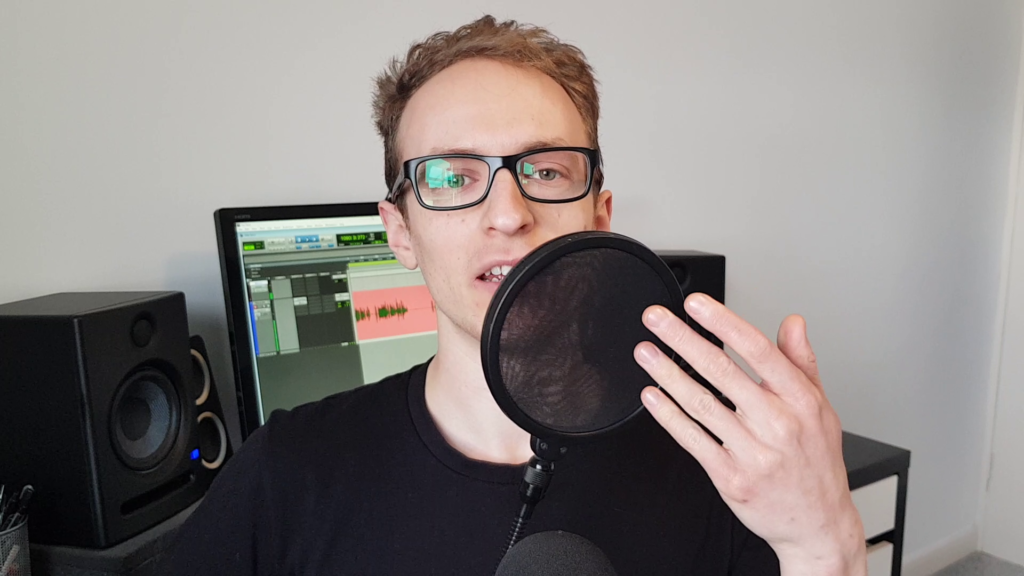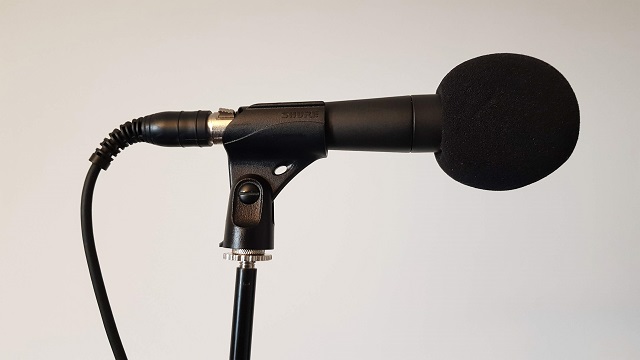Do you need a pop filter for recording vocals? I’m going to dive right into this question by giving you a direct comparison to listen to.
Here’s a clip of my vocals recorded without a pop filter –
And here’s the same passage recorded with a pop filter –
Hopefully, that’ll have sold you on why you need a pop filter to record vocals already! But nevertheless, let’s explore this a little…
What is a Pop Filter?
A pop filter (also known as a pop shield) is a piece of material that can be suspended (normally by clipping it to the mic stand) between a microphone and the vocalist. Normally made from thin, woven nylon or metal mesh, pop filters prevent the breathy peaks in your recordings that ‘P’ sounds (and other ‘plosives’) can cause. The direct blasts of air into the microphone create nasty, loud and bassy spikes that can’t always be rectified post-recording.

Placing a pop filter in between the vocalist and the microphone prevents this, and they’re quick to set up. What’s more, they’re not too pricey, and for the extra thrifty, DIY pop filters can be put together with relative ease. I go over how to place and use them for vocals in this video.
Alternatives
Positioning
If you don’t yet have a pop filter and you need to record some vocals sooner rather than later, you may need to go #nofilter. There are ways of doing this that can at least reduce the negative effects of plosives. Standing slightly off-axis (off-center) to the mic and avoiding singing directly into the mic can reduce the occurrence of those nasty, breathy spikes.

Notice how I say reduce, rather than remove – recording off axis doesn’t guarantee a completely clean recording. Also, be careful of how off-axis you’re going – depending on the pickup pattern of the mic, you might not get as clear of a recording, or it could cause it to pick up more room sound. The best thing to do is testing before recording a take.
Windscreen
A windscreen is a foam ball that attaches directly onto the microphone. They do the job of a pop filter just fine, and are commonly used in broadcasting environments. But here’s the catch – they noticeably affect the audio. Having a big foam ball covering the whole head of the microphone unsurprisingly can result in a somewhat ‘muffled’ recording. Again, it’s worth taking a test recording first as you may be better off using one of the other options if you’re recording vocals for music.

DIY
If you want to save the money and do a bit of recycling in the process, you can make your own pop filter. A wooden embroidery hoop with some old tights/pantyhose stretched over it will give you basically the same effect as a pop filter. You’ll just need a way of affixing this to the mic stand. There are plenty for detailed guides out there on how to craft one of these, this wikiHow guide shows three methods. You can also simply put a sock over the mic, although this will affect the sound quality, similarly to using a windscreen.
FAQ
Let’s close this out by clearing up a few common pop filter queries –
Do you need a pop filter for a condenser mic?
Yes. Condensers are the most commonly used type of mic for recording vocals. They rarely have any built-in shielding and are very sensitive, making them the perfect candidate for a pop filter.
Do you need a pop filter for a dynamic mic?
Sometimes. Some dynamic mics (e.g. Shure SM58 and SM7B) include a built in windshield, which will block out plosives. Other dynamic mics like the SM57 do not, though. If you’re recording vocals with one of these, you’ll need a pop filter. The best thing to do is make a test recording of a plosive heavy phrase and see how it sounds.
Do you need a pop filter for recording guitar?
No. While guitar strings and amps do vibrate and cause movement in the air (that’s how sound works), the airflow isn’t nearly as sharp or direct enough to cause any problems. I’ve never encountered any instrument that requires one. It’s possible you could experience negative effects from airflow with woodwind, brass or some percussion instruments. For example, I have experienced this with micing a hi-hat too closely, but simply changing the mic placement should be enough to avoid this.
_
A pop filter is just one of the essential pieces of gear you need to build a home studio. Drop your email below to subscribe and receive a super useful guide to everything you need to start your own studio on any budget.
Great content! Super high-quality! Keep it up! 🙂